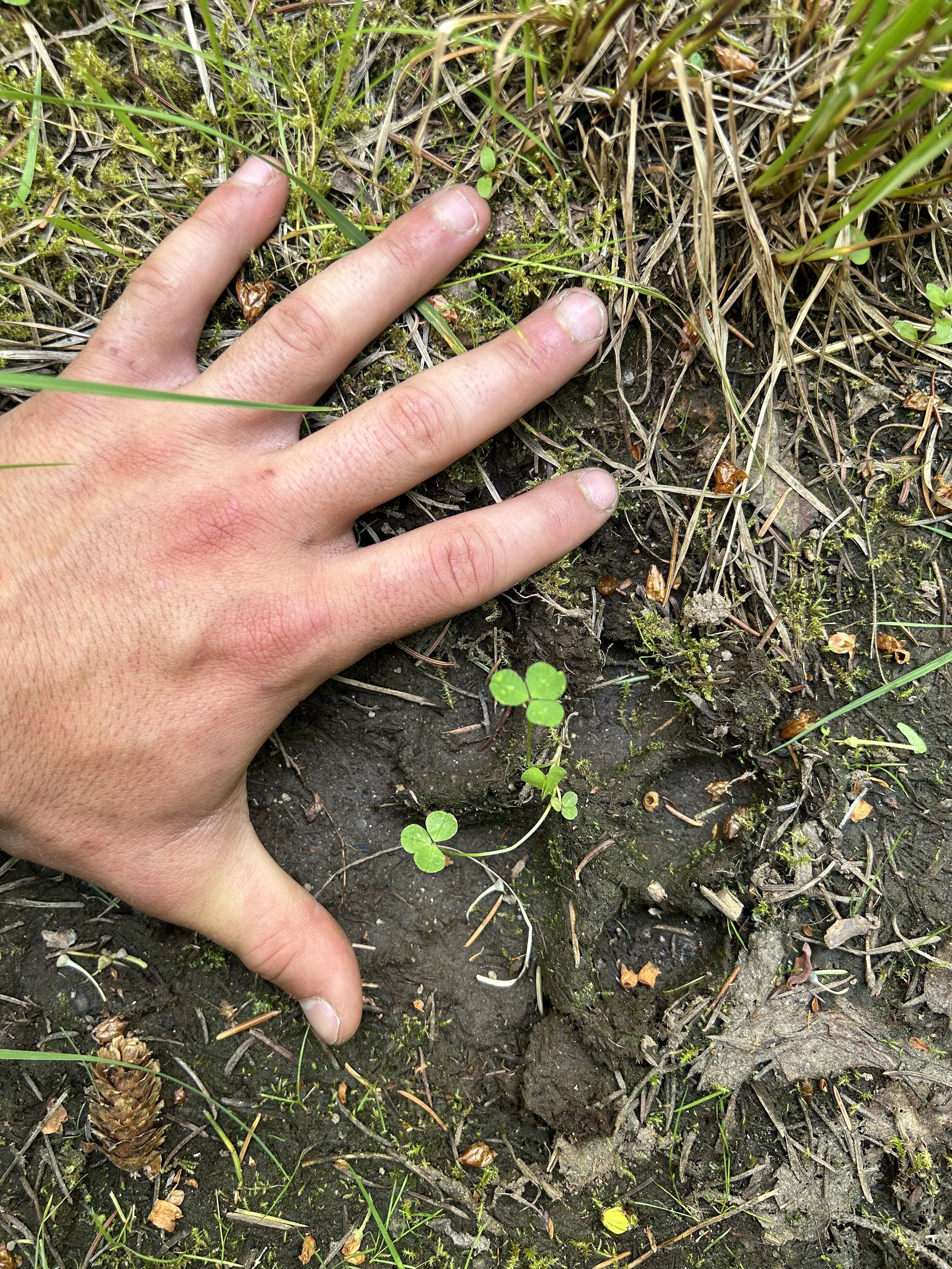Caroline Newlin
Wilderness Ranger Fellow
Big Sand Lake | Nez Perce-Clearwater National Forest
July 3-10, 2024
Selway-Bitterroot Wilderness
Sometimes what you need is a little adventure in your life. The modern workplace is a boring drudgery filled with spreadsheets and carpal tunnel. This summer, I wanted to prolong my avoidance of my fate as a desk jockey, so I signed up for 14 weeks on a trail crew in the wilderness of Montana and Idaho. This hitch, I got some adventure.
Big Sand Lake. One of the most beautiful places I've camped. (photo by Sammy Phelps)
The biggest appeal to me about coming out west was how alien the plants and animals are compared to back home. A landscape dominated by snow capped mountains even in the middle of July is unheard of. The lack of harwoods is striking. This hitch, I was a part of the whisky crew working around Big Sand Lake. The scenery and plants present were stunning, and I saw species I hadn’t seen on any of my previous hitches. Dwarf lupine, Lupinus pusillus, for example, was magnificent to see. I’m used to the large lupine plants that are found all over the Selway and Frank Church Wilderness areas, but I’d never seen dwarf lupine before. You smelled it before you saw it. The shrub layer in the forests was thick and dominated by huckleberry. Here, creeks are abundant, clear as air, and ice cold.
The canopy is dominated by lodgepole pine and firs. While working around the trail to Hidden Lake, the scenery changed. This section of the Selway-Bitterroot burned up in 2012, and you could see the remains of this fire everywhere you looked. The bleached skeletons of lodgepole pine lay stark against the sky like the ribs of some extinct animal. It’s a sharp contrast to the green, lush forest we’d seen previously.
A grouse with no sense of self-preservation (photo by Sammy Phelps)
Animals out in the Selway are pretty groovy. On our way to Big Sand Lake our first day, we ran into a mother grouse and her chicks. Grouse are about as smart as rocks. The chicks ran around where we had just walked, cheeping, with no care that we’re very large and have big feet. Mama grouse didn’t care either. She just sat there on a log staring at us and making grouse sounds. We could’ve grabbed her. Eventually, the grouse and her chicks mosied off.
A mountain lion track. Out here, you aren't at the top of the food chain (photo by Sammy Phelps).
Not all the animals were as docile and potentially puntable as the grouse. Several members of the crew spotted cougar and wolf tracks. Knowing that you are no longer at the top of the food chain is humbling. It brings to mind Doug Peacock’s definition of wilderness: “a place, and only a place, where one enjoys the opportunity of being attacked by a dangerous wild animal.” When I’m at home, my flight or fight response is triggered by laundry. Out here, it feels good to be anxious about the same things Neanderthals had nervous breakdowns over.
Unfortunately, I had to leave this hitch a few days early. I experienced a unique and devastating injury: spraining my ankle while hustling across camp to eat some corn dip. Jim, the camp cook, had made some corn dip that was so good you’d wreck your ankle. I need his recipe. It’s a truly embarrassing way to get injured.
Due to the nature of my injury, getting off of the mountain was of utmost importance. The most effective way of doing so was on horseback. It’d been a few years since I’d last ridden a horse, so I was a bit stressed. Fortunately, John, our packer, put me on Kelly, a very relaxed and friendly mule. Riding down the mountain on the back of this mule in a chain brought to mind Forest Service workers 100 years ago doing the same sort of work we’re doing, with the same tools. It makes you feel like you’re part of something bigger than yourself.
On the way down, John told me about whitebark pine, which is being devastated by white pine blister rust, an invasive fungus that uses members of the Ribes genus as a host. We saw one whitebark pine tree on the way, which is the first of its species I’ve ever seen. It was a young tree, less than 10 years from the look of it, and I imagine it’ll succumb to the fungus soon. Watching a species disappear from the landscape is a terrible feeling.
One of John's horses (photo by Sammy Phelps).
John also told me about bear grass. I didn’t know this, but bear grass typically flowers once every seven years! The hillsides were a sea of them. I picked a good year to be out here. The excitement and unparalleled beauty made everything worth it.
This project was made possible with funds from the Nez Perce-Clearwater National Forests, Idaho Fish & Game Access Funds, and private SBFC donors.
Snow Camp, NC
North Carolina State University- Forest Management
Caroline is passionate about the outdoors and has done outdoor work for years. In high school, she did trail work for her local park service and worked for a canoe and kayak company most summers. She has always wanted to visit Montana and Idaho, and this fellowship has given her that opportunity, while also learning about wilderness stewardship. She plans on hiking the whole Appalachian Trail one day, along with visiting all the national parks in the United States. Her hobbies include rock climbing, whitewater kayaking, backpacking, and gardening.





